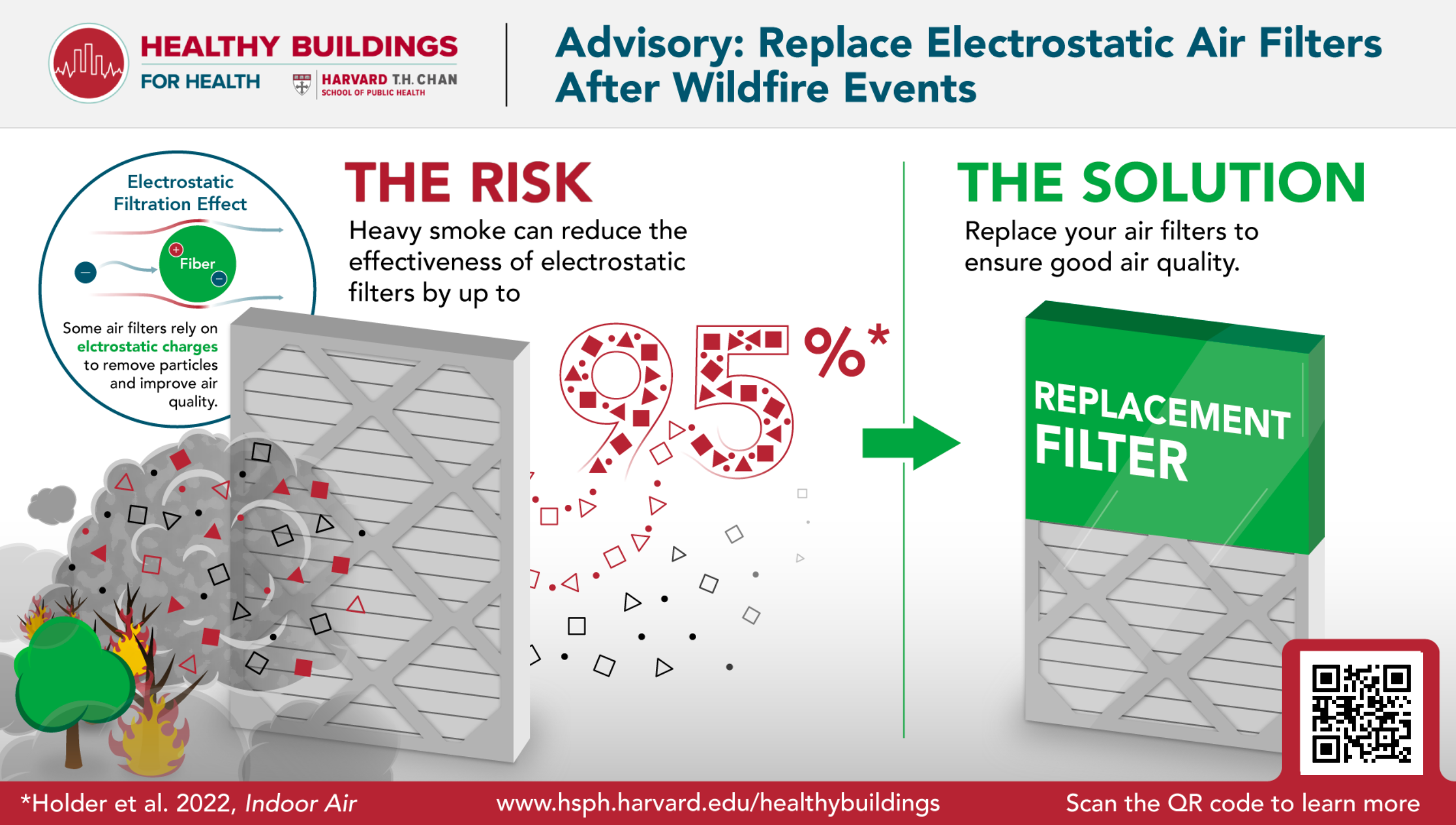
Did you know that some high performance air filters use electrostatic charges to improve particle removal efficiencies? Did you know that wildfire smoke can reduce the effectiveness of these filters? Continue reading below to learn more about air quality and health impacts from wildfires or jump straight to the filtration section to learn more about steps to take.
The Threat: Wildfires, Air Quality, and Your Health
Wildfires generate smoke and harmful pollutants that degrade air quality and threaten our health [1]. While it is recommended to minimize your time outside when outdoor air quality is poor, it’s important to keep in mind that this polluted outdoor air can make its way indoors. Fortunately, there are steps you can take to help reduce your indoor exposure to wildfire air pollution and protect your health. With recent years showing an increase in the frequency and severity of wildfire events, which is expected to continue in the future [2], understanding and implementing strategies to protect your health will become increasingly important. In this blog, we discuss basic health and safety considerations related to wildfire events, with a focus on particles and filtration strategies.
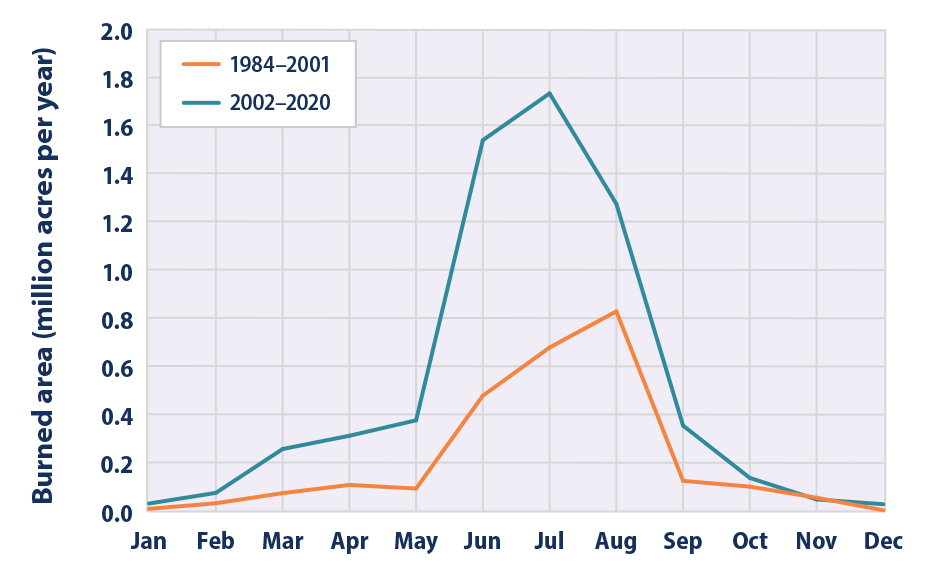
Figure 1: Comparison of monthly burned area due to wildfires in the United States between 1984–2001 and 2002–2020 via the EPA [3]
Wildfires produce a complex mixture of air pollutants, including fine particulate matter, referred to herein as PM2.5; this denotes small solid particles and liquid droplets in the air that are smaller than 2.5 micrometers in diameter, which is roughly 20-30 times smaller than the diameter of a human hair [4]. Since these particles are so small, they are easily inhaled deep into the respiratory system, which can cause a myriad of negative health effects. These can range from coughing and throat and nose irritation to exacerbated asthma symptoms, altered heart and lung function, heart attacks, and even premature mortality, particularly among those with underlying health conditions [5]. One study estimated chronic health impacts from indoor exposures to various air pollutants and found PM2.5 to account for the greatest burden [6], making them especially important to protect ourselves from.
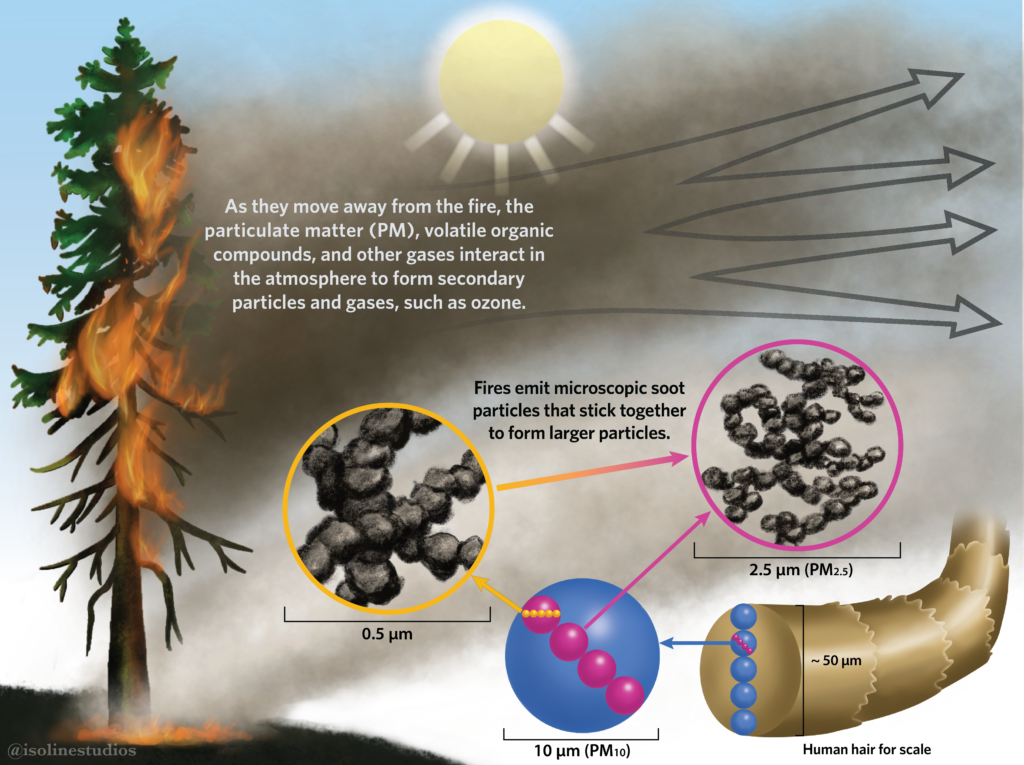
Figure 2: The composition of wildfire smoke; Credit: Jen Burgess/IsolineStudios for BC Centre for Disease Control[7]
Various jurisdictions have recognized these concerns and have set ambient air quality exposure standards to protect health; one example being the National Ambient Air Quality Standards in the US [8]. Since wildfire events produce such high PM2.5 concentrations, these health-based exposure thresholds are easily exceeded in affected areas, both in close proximity and from far-reaching smoke waves [9]. There are many resources available to check outdoor air quality levels and what they mean for your health [10]. One example is an “Air Quality Health Index”, which helps translate these quantitative air quality measurements (e.g., fine particulate matter measured at a certain level) to a qualitative interpretation of what they mean for your health (e.g., air quality is “moderate”) and what preventative steps you could take to reduce your exposure and protect your health. These recommendations typically center on limiting your time outdoors, but you might be wondering what can you do to stay safe indoors?
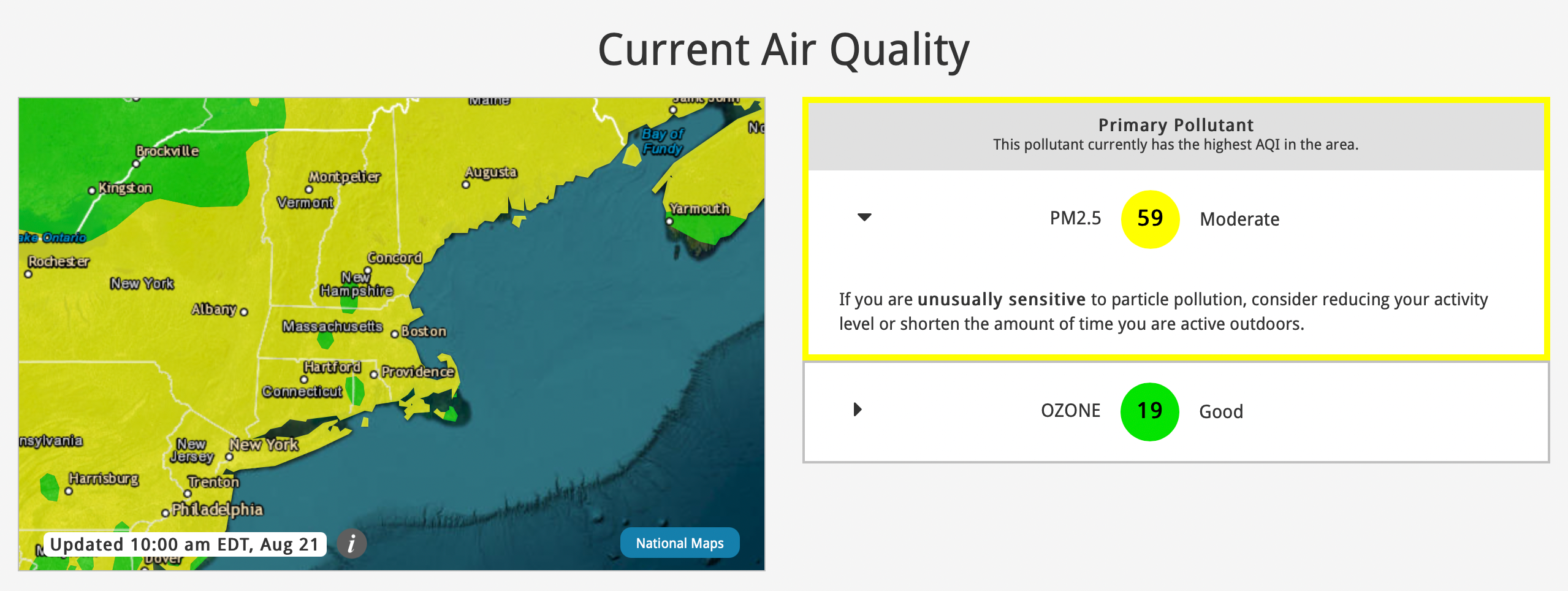
Figure 3: Sample AQI from AirNow for Cambridge, MA [10]
Protecting Your Health Indoors
To help limit the amount of polluted outdoor air you are exposed to indoors, consider taking steps that follow the “hierarchy” of good indoor air quality, which focuses first on source control, then ventilation, followed by air cleaning. Here we present strategies specific to wildfire smoke:
Source control
The source of wildfire smoke is located outdoors; therefore, you first want to limit the amount of polluted outdoor air that makes its way indoors. Start by closing all windows and doors, and ideally seal up any noticeable cracks or openings in exterior walls (i.e., reduced infiltration).
Particle Filtration & Air Cleaning:
Particle filters (sometimes called “furnace filters” or “media filters”) are common in most ventilation systems and standalone portable air cleaners (or “air purifiers”). These particle filters come in different sizes and ratings or performance levels. If you’d like to learn more about filtration performance and ratings and/or portable air cleaners, feel free to check out our past blogs on Do-it-yourself portable air cleaners [11] and portable air cleaner considerations with respect to COVID-19 [12]. In general, the higher the filter rating and the snugger the installation (e.g., no gaps around the filter), the more effective the filter will be at removing these fine particles from the air, thus protecting your health.
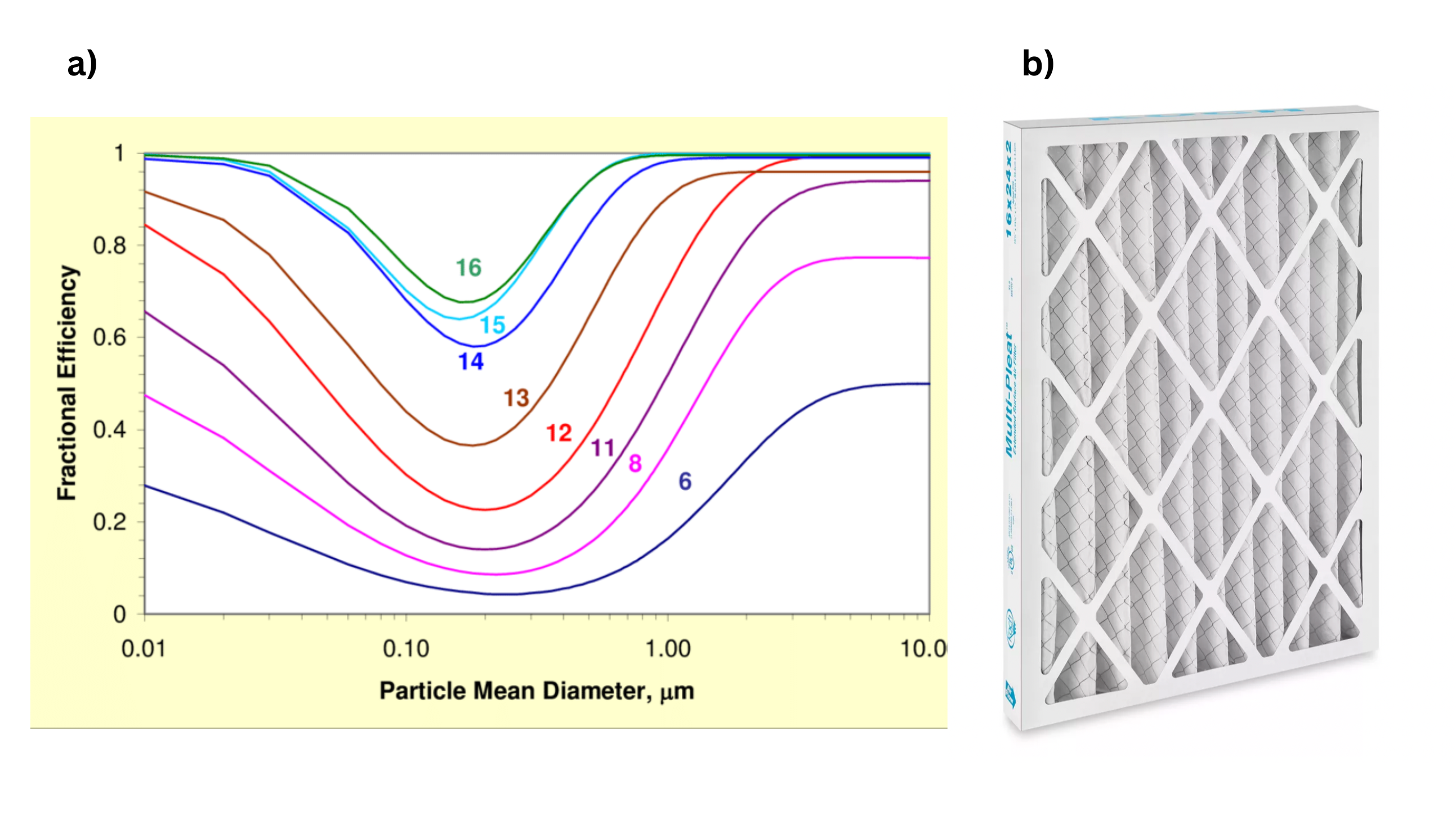
Figure 4: (a) theoretical MERV performance curve [13], and (b) classic particle filter with pleated media [14]
As shown in the above image, media filters won’t remove all particles, but the higher rated ones should remove most. Focusing specifically on wildfire events, high performance particle filters (i.e., MERV-13 and higher) are ideal, since the average particle size of wildfire smoke is 0.3 um, which is the hardest size to filter, as shown in the filter efficiency curves below. Many studies have shown that high performance particle filters are effective at reducing indoor concentrations of fine particulate matter during smoke events, with measured reductions in particle counts ranging from 61-85% with the short-term use (12-hour test periods) in dwellings with wood burning stoves [15]. However, other studies have reported large drops in filter performance when exposed to smoke [9] and over time.
Particle filters use different mechanisms to remove particles from the air [16]–[18]. Traditional particle filters rely on mechanical approaches for removing particles (this basically means particles are physically stopped/blocked by the filters by attaching to the filter fibers in some way). Many of the higher-rated particle filters (e.g., MERV-13 filters) incorporate an electrostatic charge on the filter fibers to help remove particles with an opposite charge through electrostatic attraction [17]. Particle removal efficiencies can decline with time in these filters [9], [19]–[22], based on how the “loading” (build up of particles) impacts the intended particle removal mechanisms of the filter.
Impact of Wildfires on Filter Performance
Wildfires bring an additional layer of complexity to this performance decline issue. It is postulated that deposited smoke particles, which carry a charge [23], on these electrostatically-charged filters can either mask or counter the intended filter charge, thus reducing the intended electrostatic removal mechanism [9], [21]. A recent controlled chamber study demonstrated that the Clean Air Delivery Rate (CADR) of a Do-It-Yourself (DIY) air cleaner using 1 inch electrostatic MERV-13 filters is reduced significantly when the filter is loaded with smoke [9]. The researchers observed that the CADR of the DIY air cleaners equipped with electrostatic air filters was reduced by 95%, while airflow through the filter was maintained (only 7% increase in pressure drop), pointing to a loss in the electrostatic attraction mechanism as the likely cause of filter performance decline since airflow appeared to be maintained. This occurrence has been observed in other studies with cigarette smoke and intentionally discharging the filter with isopropyl alcohol [9]. Other studies that investigated longer term and more realistic test conditions note similar findings, with one study observing a substantial reduction in particle removal efficiency over a 19-week period of operation in an air handling unit that supplies outside air [19]. The exact mechanisms and magnitude of the decrease is difficult to predict in practice, due to numerous factors, such as the amount and composition of particle loading on the filter [21]. Nevertheless, reductions in filtration effectiveness can be up to a factor of two or more [21].

Figure 5: Mechanism of airborne PM filtration via (a) mechanical and (b) electrostatic effects [24]. Reproduced with permission from Ref. [25]. Copyright 2013 American Chemical Society.
Filtration Steps to Take.
So, what to do if you have an electrostatically charged filter? Or how do you know if you even have one? Check the type of filter you purchased and installed. It will have something like “electrostatic” or “electrostatically-charged” in the name or description from the manufacturer. If you’re using a high-performance filter (e.g., MERV-13 or higher), it’s likely you have one. If you suspect or determine that you’re using one or more of these in your ventilation system (e.g., furnace, heat recovery ventilator, etc.) or in a portable air cleaner (or “air purifier”), consider replacing the filter after a wildfire event. Since the smoke particles can diminish the effectiveness of the filter charge, replacing them after the event and associated outdoor air pollution has subsided is a prudent way to help ensure your space is receiving a high level of particle filtration, thus promoting good health in turn.
It is also important to reiterate that although some studies show that smoke can substantially diminish the effectiveness of these electrostatically-charged filters in a controlled experimental setting, the research on this topic is small, and as mentioned, many studies have shown them to still be effective at reducing indoor particle concentrations, to some degree, during real-world smoke events [26]. Regardless of the actual reductions in performance, the average size of smoke particles means that choosing a high performance (i.e., MERV-13 or higher) particle filter is a theoretically effective step, as some studies have shown even a MERV-11 filter to have almost half the CADR of a MERV-13 filter when initially tested with smoke particles [9]. Beyond filter selection, being prudent about filter replacement, particularly after periods of heavy pollution, such as during wildfires, is always a good idea for your health and wellbeing.
SIDE NOTE: You should also keep in mind that electrostatically charged filters are different from electrostatic precipitators (often referred to as ESPs for short). ESPs actively charge incoming particles using electricity to remove them from the air by attracting them to an oppositely charged electric plate [17]. While these devices can be effective at removing smoke, they come with other potential disadvantages, such as high electricity consumption, demonstrated reductions in performance with loading, and most concerning for health, the potential to generate harmful air pollutants [17].
Sources:
[1] WHO, “Wildfires Fact Sheet,” 2023. https://www.who.int/health-topics/wildfires (accessed Aug. 13, 2023).
[2] O. US EPA, “Climate Change Indicators: Wildfires,” Jul. 01, 2016. https://www.epa.gov/climate-indicators/climate-change-indicators-wildfires (accessed Aug. 13, 2023).
[3] O. US EPA, “Climate Change Indicators: Wildfires; Figure 6,” Jul. 01, 2016. https://www.epa.gov/climate-indicators/climate-change-indicators-wildfires (accessed Aug. 14, 2023).
[4] O. US EPA, “Particulate Matter (PM) Basics,” Apr. 19, 2016. https://www.epa.gov/pm-pollution/particulate-matter-pm-basics (accessed Aug. 13, 2023).
[5] O. US EPA, “Health and Environmental Effects of Particulate Matter (PM),” Apr. 26, 2016. https://www.epa.gov/pm-pollution/health-and-environmental-effects-particulate-matter-pm (accessed Aug. 13, 2023).
[6] J. M. Logue, P. N. Price, M. H. Sherman, and B. C. Singer, “A Method to Estimate the Chronic Health Impact of Air Pollutants in U.S. Residences,” Environ. Health Perspect., vol. 120, no. 2, pp. 216–222, Feb. 2012, doi: 10.1289/ehp.1104035.
[7] J. Burgess, Wildfire Smoke. Accessed: Aug. 14, 2023. [Graphics]. Available: http://www.bccdc.ca/health-info/prevention-public-health/wildfire-smoke
[8] O. US EPA, “NAAQS Table,” Apr. 10, 2014. https://www.epa.gov/criteria-air-pollutants/naaqs-table (accessed Aug. 13, 2023).
[9] A. L. Holder, H. S. Halliday, and L. Virtaranta, “Impact of do-it-yourself air cleaner design on the reduction of simulated wildfire smoke in a controlled chamber environment,” Indoor Air, vol. 32, no. 11, p. e13163, 2022, doi: 10.1111/ina.13163.
[10] EPA Office of Air Quality Planning and Standards, “AirNow.gov.” https://www.airnow.gov/ (accessed Aug. 13, 2023).
[11] Healthy Buildings Program at Harvard T.H. Chan School of Public Health, “Do-It-Yourself Portable Air Cleaners,” Schools For Health. https://schools.forhealth.org/diy-air-cleaners/ (accessed Aug. 14, 2023).
[12] P. Salimifard, E. Jones, and J. Allen, “Portable Air Cleaners: Selection and Application Considerations for COVID-19 Risk Reduction,” Healthy Buildings Program at the Harvard T.H. Chan School of Public Health, 2020. [Online]. Available: https://schools.forhealth.org/wp-content/uploads/sites/19/2020/08/Harvard-Healthy-Buildings-Program-Portable-Air-Cleaners.pdf
[13] W. J. Kowalski and W. P. Bahnfleth, “MERV filter models for aerobiological applications,” Air Media, vol. 2002, pp. 13–17, 2002.
[14] “Pleated Air Filters – 16 x 24 x 2.” https://www.uline.com/Product/Detail/S-24676/Warehouse-Fans-and-HVAC/Pleated-Air-Filters-16-x-24-x-2-MERV-8 (accessed Aug. 14, 2023).
[15] J. F. Hart, T. J. Ward, T. M. Spear, R. J. Rossi, N. N. Holland, and B. G. Loushin, “Evaluating the Effectiveness of a Commercial Portable Air Purifier in Homes with Wood Burning Stoves: A Preliminary Study,” J. Environ. Public Health, vol. 2011, p. e324809, Jan. 2011, doi: 10.1155/2011/324809.
[16] Z. Xu, “Filtration Mechanism of Fine Particle,” Fundam. Air Clean. Technol. Its Appl. Cleanrooms, pp. 133–183, Aug. 2013, doi: 10.1007/978-3-642-39374-7_3.
[17] EPA Indoor Environments Division, “Residential Air Cleaners – A Technical Summary,” U.S. Environmental Protection Agency (EPA), Office of Radiation and Indoor Air, Indoor Environments Division, EPA 402-F-09-002, Jul. 2018. [Online]. Available: https://www.epa.gov/sites/default/files/2018-07/documents/residential_air_cleaners_-_a_technical_summary_3rd_edition.pdf
[18] P. Wargocki et al., “ASHRAE Position Document on Filtration and Air Cleaning,” ASHRAE, Atlanta, Georgia, Feb. 2021. [Online]. Available: https://www.ashrae.org/file%20library/about/position%20documents/filtration-and-air-cleaning-pd-feb.2.2021.pdf
[19] P. C. Raynor and S. J. Chae, “The Long-Term Performance of Electrically Charged Filters in a Ventilation System,” J. Occup. Environ. Hyg., vol. 1, no. 7, pp. 463–471, Jul. 2004, doi: 10.1080/15459620490467783.
[20] R.-R. Cai, H. Lu, and L.-Z. Zhang, “Mechanisms of performance degradation and efficiency improvement of electret filters during neutral particle loading,” Powder Technol., vol. 382, pp. 133–143, Apr. 2021, doi: 10.1016/j.powtec.2020.12.061.
[21] Siegel, J. A. “Primary and Secondary Consequences of Indoor Air Cleaners.” Indoor Air 26, no. 1 (February 2016): 88–96. https://doi.org/10.1111/ina.12194.
[22] M. S. Zuraimi, M. Vuotari, G. Nilsson, R. Magee, B. Kemery, and C. Alliston, “Impact of dust loading on long term portable air cleaner performance,” Build. Environ., vol. 112, pp. 261–269, Feb. 2017, doi: 10.1016/j.buildenv.2016.11.001.
[23] P. Gwaze, O. Schmid, H. J. Annegarn, M. O. Andreae, J. Huth, and G. Helas, “Comparison of three methods of fractal analysis applied to soot aggregates from wood combustion,” J. Aerosol Sci., vol. 37, no. 7, pp. 820–838, Jul. 2006, doi: 10.1016/j.jaerosci.2005.06.007.
[24] E. Tian, Y. Gao, and J. Mo, “Experimental studies on electrostatic-force strengthened particulate matter filtration for built environments: Progress and perspectives,” Build. Environ., vol. 228, p. 109782, Jan. 2023, doi: 10.1016/j.buildenv.2022.109782.
[25] C. Wang and Y. Otani, “Removal of Nanoparticles from Gas Streams by Fibrous Filters: A Review,” Ind. Eng. Chem. Res., vol. 52, no. 1, pp. 5–17, Jan. 2013, doi: 10.1021/ie300574m.
[26] T. Li and J. Siegel, “Laboratory performance of new and used residential HVAC filters: Comparison to field results (RP-1649),” Sci. Technol. Built Environ., vol. 26, no. 6, pp. 844–855, Jul. 2020, doi: 10.1080/23744731.2020.1738871.




